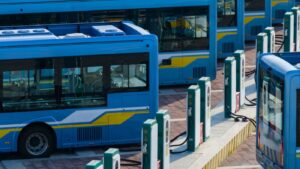Intelligent Traffic Systems: Implementation and What’s Down the Road?
According to INRIX’s 2017 Traffic Scorecard study, the estimated total economic costs from traffic congestion for the US, UK, and Germany amounted to almost $461 billion in 2017. The dollar value increases when the calculation includes data from the other 35 countries in this study. Furthermore, several major developing countries were excluded from this study, so total global economic impact from traffic congestion could be significantly higher than what INRIX has reasonably estimated. In other words, the economic cost of traffic congestion coupled with growing urbanization is a big problem. It also means that the traffic management market is a significant one, with a value of $5.4 billion and a CAGR of 18.2%.
The challenge of moving people will only get worse, as the United Nations recently projected world population to reach 9.8 billion people in 2050, meaning an increase of nearly 2.2 billion people over the next 3 decades. Furthermore, there is an ongoing mass urbanization movement, with more people moving to urban areas and cities that are housing over 50% of the world’s population. As more people congregate in cities, existing city infrastructures that are already aging and nearing their capacities face even more challenges to support the growing number of residents.
What is an intelligent traffic management system?
Current traffic management systems are limited in their abilities to adapt based on real-time traffic conditions. For example, traditional timing systems for traffic signals are programmed based on historical traffic data and are unable to dynamically adjust timing due to irregular events like traffic accidents and construction. Some major cities have implemented a synchronized traffic signal system with the goal of increasing traffic flows at major gridlock intersections, which has shown a reduction in travel time in Los Angeles. However, such systems are still based on a centralized approach. When flow is disrupted at any point within the system, say a traffic accident, it creates a knock-on effect and synchronized traffic signals are not able to adjust their pre-programmed timings accordingly.
An intelligent traffic management system could help cities manage traffic flow more efficiently. The backbone of any intelligent traffic management system is wireless connectivity throughout the city’s infrastructure. Relevant technologies include 4G, 5G, low power wide area network (LPWAN), catering to the various end use applications that require different types of networks. Incumbents like Cisco and AT&T are providing cities with 4G and 5G services for traditional high bandwidth applications like traffic signal control, while startups like Sigfox and Actility have developed Low Power Wide Area Network (LPWAN) technologies to support the influx of low power sensors.

Although all traffic management systems have certain existing hardware components, they are far from being “smart” enough to provide any advanced management functions. Traditional cameras can monitor traffic flow; however, they are unable to differentiate other variables such as vehicle types, cyclists, and pedestrians. Furthermore, video footage by itself provides little value as cities can only resort to a reactive approach after traffic incidents have occurred. Rotterdam has recently partnered with FLIR to install FLIR’s thermal cameras to distinguish cyclists from vehicles in an effort to reduce wait time for cyclists. Copenhagen, another high bicycle traffic city, also installed a similar system to prioritize traffic signals for city buses and cyclists. On the software aspect, TrafficVision is an example of a company that has developed a traffic intelligence software to analyze standard video footage to provide real-time incident alerts.
Software innovations then perhaps play the most important role in an advanced traffic management with their ability to analyze the various data input, and subsequently provide insights on traffic reduction and prevention recommendations. There are obviously a lot more complexities and variations in end use cases that can adequately described here, but the main takeaway is that software innovation such as artificial intelligence can potentially transform traffic management from a reactive-approach to a proactive one.
Many cities have implemented some type of traffic management system upgrades – wireless networks, surveillance cameras, and connected streetlights – to improve their existing infrastructures. To implement a true advanced traffic management solution, it’s far more complex than a single standalone technology, and requires a combination of connectivity, hardware, and software technologies to work together as one system. In addition to preparing for the next generation of transportation, one immediate benefit should be the reduction of emissions by reducing idling and sitting in traffic.
A few illustrative examples of recent pilot programs being implemented in cities are listed below:

Challenges in implementation
Because an advanced traffic management system requires multiple technology layers, municipal governments often lack the expertise in identifying and selecting the right mix of solutions. Several cities (New York, Tampa, and others) needed to hire a project development contractor who is an expert in designing and implementing traffic systems, which further adds to the overall project costs. Although some companies do offer a vertically-integrated offering, newer players are still in the stage of technology development instead of system integration.
Technological challenges aside, there are also inherent challenges in changing a city’s infrastructure. As traffic management is a safety critical system, regulatory policy and reliability testing requirements can impede the deployment of new technologies. Municipal governments also have limited budget for major radical infrastructure upgrades and are also more conservative than the private sector, with city officials often more resistant to change and adopting new technologies. Finally, government procurement procedures often require success case studies, which translate to a chicken vs. egg issue for technology innovators.
What’s next?
Advanced traffic management is only one tangible aspect of an intelligent transportation system. Smart parking management and route planning are just a few other examples that shape a bigger intelligent transportation system. Moreover, with the introduction of autonomous vehicles and multi-modal transportation options for city dwellers, the interaction between various city infrastructures becomes even more complex. For our next transportation blog post, we will look into some of the frontier opportunities and challenges on next generation urban transportation management systems, stay tuned.


